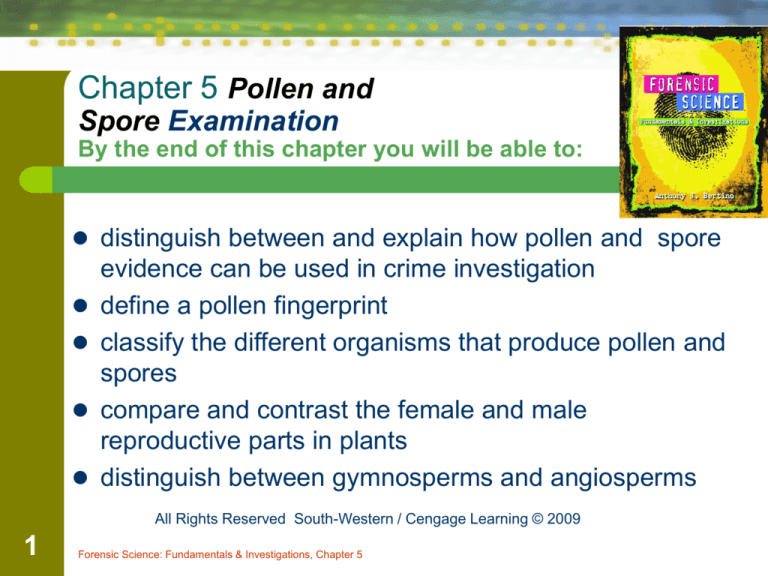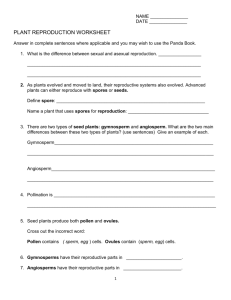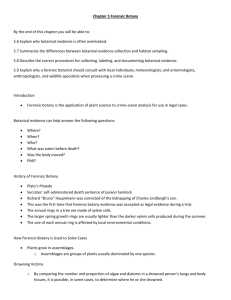
Chapter 5 Pollen and
Spore Examination
By the end of this chapter you will be able to:
distinguish between and explain how pollen and spore
evidence can be used in crime investigation
define a pollen fingerprint
classify the different organisms that produce pollen and
spores
compare and contrast the female and male
reproductive parts in plants
distinguish between gymnosperms and angiosperms
All Rights Reserved South-Western / Cengage Learning © 2009
1
Forensic Science: Fundamentals & Investigations, Chapter 5
Chapter 5 Pollen and
Spore Examination
By the end of this chapter you will be able to:
summarize the different methods of pollination and their
2
relevance in solving crimes
identify the different ways spores are dispersed
state characteristics of pollen and spores that are
important for forensic studies
summarize how pollen and spore evidence is collected
at a crime scene
describe how pollen and spore samples are analyzed
and evaluated
Forensic Science: Fundamentals & Investigations, Chapter 5
Introduction
Forensic palynology is a specialized field
that studies pollen and spore evidence.
Since both pollen and spores have
resistant structures, they at times can
help determine such things as whether a
body was moved, a crime’s location,
whether it occurred in a city or in the
country, or in which season it may have
occurred.
3
Forensic Science: Fundamentals & Investigations, Chapter 5
Pollen-Producing Plants
Forensic palynologists know each pollen-producing
plant provides a pollen fingerprint—a specific type of
pollen grain. They also know there will be a certain
number of grains found in a specific geographical
area during particular times of the year.
– Examples of non-seed plants would be ferns,
mosses, liverworts, and horsetails.
– Examples of seed plants would be gymnosperms
(cycads, ginkgoes, and conifers like an evergreen)
and angiosperms (flowering plants like roses).
4
Forensic Science: Fundamentals & Investigations, Chapter 5
Gymnosperms
Gymnosperms are the oldest seed plants.
Evergreens are conifer gymnosperms.
They produce their seeds in a hard, scaly
structure (cones).
Pollination occurs when pollen is transferred
from the male cones to the female cones.
Which of the two structures shown above
transfers pollen to the other?
5
Forensic Science: Fundamentals & Investigations, Chapter 5
Angiosperms
The most recent plant group to evolve is known as
the flowering plant.
Identify its different parts in the illustration above.
Plants in this group produce seeds in an enclosed
fruit.
These plants are very diverse and include corn,
oaks, maples, and the grasses.
6
Forensic Science: Fundamentals & Investigations, Chapter 5
Types of
Pollination
Pollination is the transfer of pollen from the male
part of a plant to the female part of a seed plant.
– Self-pollination, in flowering plants, involves
transfer of pollen from an anther to the stigma
within the same flower, as in pea plants.
– Cross-pollination (illustrated above) involves
two distinct plants.
7
Forensic Science: Fundamentals & Investigations, Chapter 5
Types of Pollination
Pollen of self-pollinating plants is generally of
lower value in forensic studies because it is
rarely encountered.
Pollen can be carried by wind, animals, or
water.
Pollen carried by wind may be less effective
for determining direct links between
individuals and places because of the long
distances over which it can be carried.
8
Forensic Science: Fundamentals & Investigations, Chapter 5
Spore Producers
Spore producers include certain protists
(algae), plants, fungi, and the bacteria that
produce a unique type of spore.
Bacterial spores, endospores, can cause
diseases such as anthrax and botulism.
Spore analysis has the advantage that the
spores possibly can be grown and the species
identified with certainty.
9
Forensic Science: Fundamentals & Investigations, Chapter 5
Spore
Dispersal
Algae disperse spores into water or air.
Spore producers have the same value in
investigations as pollen from wind-pollinated
plants.
Identify the different parts of the mushroom
illustrated above and explain how its spores
are released into the wind.
10
Forensic Science: Fundamentals & Investigations, Chapter 5
Pollen and Spore Identification in
Solving Crimes
Angiosperm pollen grains
pollen grains
Gymnosperm
The outer shell of a pollen grain and spore (the
11
exine) has a complex and unique structure.
These are revealed under a microscope.
Identification can provide important trace
evidence in solving crimes.
Forensic Science: Fundamentals & Investigations, Chapter 5
Finding Pollen and Spores
12
Forensic Science: Fundamentals & Investigations, Chapter 5
How to Collect Pollen and Spores
During an investigation, control samples must be
collected as well as evidence samples.
Samples must be collected wearing gloves and with
clean tools (such as brushes and cellophane tape)
and placed in sterile containers, which then must be
sealed and labeled with care.
Sampling instruments must be cleaned after each
use, or new ones must be used.
Collected evidence must be secured, and the chain
of custody must be maintained.
13
Forensic Science: Fundamentals & Investigations, Chapter 5
Analyzing Pollen and Spore Samples
To identify pollen and spores, specialists can use a
compound light microscope, a scanning electronic
microscope, reference collections that may consist
of photos and illustrations or perhaps even actual
dried specimens arranged systematically
(herbariums).
Pollen and spore evidence that has been
collected, analyzed, and interpreted can be
presented in court.
These “fingerprints” can be used to confirm certain
aspects of a crime.
14
Forensic Science: Fundamentals & Investigations, Chapter 5
. . . . . . . . . . . . . . . . . Summary
Forensic palynology can indicate something about the
15
geographical origin and the time or season of a crime.
Spores and pollen can be dispersed by wind, by water, or by
animals.
Pollen from insect-pollinated plants tends to give more
specific location data than from wind-pollinated plants.
Pollen collected at a crime scene must include baseline
samples from the area for comparison.
Collection of pollen and spore evidence must be performed
carefully to avoid contamination.
Forensic Science: Fundamentals & Investigations, Chapter 5





